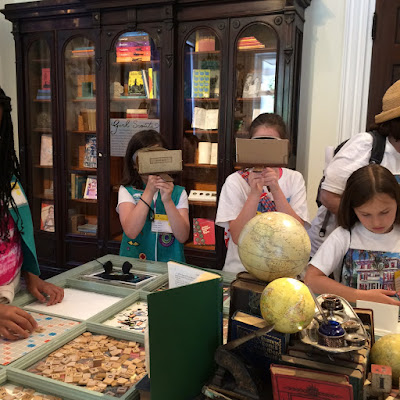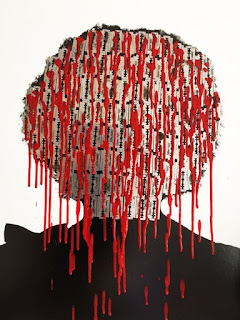I go to lots of museums every year. If you really want to know how many, you can check out the Google map I keep of my museum visits (museum nerdy I know). Some I go to for work, some for pleasure. Even with those ones visited for fun, I find myself pondering both the why and the how of the work we do. As I reflected about the year, I was always thinking about both the experience and the people I was with--clients, colleagues, friends or family. This year's top ten roundup, turned into a baker's dozen, is all about the experiences. Some of these connect to earlier posts, others were equally valued but never quite made it into the blog. I hope you enjoy them even a bit as much as I did. It's been a tough year, but there are always bright spots. I'll be curious if any of you see any common threads in what made my list. If so, please share your thoughts in the comments.
I love the Rijksmuseum for lots of reasons but I loved this exhibit when I saw it in November. For seven years, beginning in 1636, artist Post was in faraway Brazil, sketching and painting flora and fauna.What made the exhibit great? First, the drawings were discovered as part of a digitization project; second, it was a collaborative effort between an art museum and a natural history museum (see the llama above) third, a witty, clean installation; and fourth, the exhibit encouraged deep looking and drawing. It was just fun, made more fun by seeing it with an old friend and museum-lover Irina Leonenko.
Columbus Art Museum, Columbus, Ohio
The Columbus Art Museum has made creativity the centerpiece of their work. Rainey Tisdale and I were lucky enough to get a walkthrough of their galleries with Cindy Foley, Deputy Director for Learning and Experience and we got to see a museum that embraces creativity in full flower. For instance, many museums would balk at putting a big jigsaw puzzle right in front of the work of art, as above. But these two visitors (notice, adults) were engaged in deep closing looking. They would pick up a puzzle piece, come in close to the painting, look and ponder, go back to the puzzle, talk to each other, and repeat. They spent far more time in front of this painting than they ever would have without this encouragement. In a gallery featuring American art, they're working to expand our ideas of the "American story," visitors were invited to share where their American story begins, and their vision for the future.
Ukraine's Cultural Heritage Sector, Kyiv and L'viv, Ukraine
This fall, I returned to Ukraine with Lithuanian colleague Vaiva Lankeliene (that's her above, with our thoughtful colleague Vasyl Rozhko, digging into data over coffee in L'viv) to assess the state of Ukraine's cultural heritage. It was incredible to have to opportunity to think deeply about not only the present but the past and the future. I found, not surprisingly, some everyday heroes who can inspire all of us as they work to shape a nation's future.
Royal Newfoundland Constabulary Headquarters Exhibit
Royal Newfoundland Constabulary Headquarters Exhibit
It was something entirely new for me to do an exhibit in a police headquarters. Thinking about audiences was challenging. But that's not what made this experience memorable. It was that I had the chance to think about community in an expanded way. The Constabulary (the oldest police force in North America) is a community unto itself, with long, proud traditions. They wanted to honor those traditions but also wanted the exhibit to reach out to the greater Newfoundland community in the same ways they connect every day with citizens. Huge credit goes to the museum committee, headed by Jim Lynch, who were willing to let talented designer Melanie Lethbridge and I put forth different ideas on both concept and design. This volunteer committee was far more willing to talk and think about risk-taking in exhibits than many museums.
Big crowded art museums are always tough. There are too many people, my knowledge of art history never seems quite enough, the labels are either amazingly uninformative or filled to the brim with art historical terms I don't understand. Over the last four years of working with Context Travel, I've had the chance to take some great walks in great cities and museums. Last winter, in Florence with Context staff, I was tired, had a cold, and initially thought, oh, I can skip this. I've been to the Uffizi before. But Alexandra Lawrence, a Context docent (the word the company uses for their guides) and art historian, made the Uffizi make sense to me. She put forth a clear theme for the walk, returned to it throughout, carefully selected individual works to move that forward, and had us look deeply, all the while sharing her own great enthusiasm. The kind of museum tour we all want and rarely get. I left feeling both renewed and smarter.
Without a doubt, the best labels I saw all year. Funny, irreverent, thoughtful, meaningful--and somehow they absolutely reflected the spirit of the city. At the same time, the labels never shied away from the political--from women's rights to the 1916 Uprising.
Juliette Gordon Low Birthplace, Savannah, GA
I'm a former Girl Scout myself but honestly, hadn't thought much about the experience in years until Lisa Junkin Lopez, director at the Juliette Gordon Low Birthplace in Savannah asked me to do some evaluation of a new visitor experience, the re-imagined Library. JGLB has a great staff, up for anything, but what made this experience really great were the girls themselves. Girls who were inspired, who wanted to change the world, who believed that they could invent and be anything. In these challenging times, it was a great reminder that our museums can, and should, inspire all kinds of people, in all kinds of ways.
I arrived in Riga last January to facilitate a series of workshops. But one of the first things that happened was to get a tour of the newly renovated National Art Museum from Una Sedlience, their deputy director. In the dark late afternoon, we got to wander through this beautiful building--before the art was installed. Up grand staircases, into magnificent rooms, through up-to-date open storage waiting to receive the paintings, and then up on the roof, overlooking the historic city. A magical experience in a gorgeous city.
Mystic Seaport, Mystic, CT
At a workshop on increasing visitor engagement in exhibits, we experimented in the galleries devoted to Soviet-era history. Museum colleagues were asked to develop questions, post them near objects, and then, take some time and answer a question or two. I was blown away by the quality of the questions, and fascinated by the answers. Was the education system better? Is your memory of Soviet times really the memory of your grandparents? Is collective better than individual? A grand experiment and one I'll long remember.
The Midwest Museum Association held its conference in Minneapolis this year, and a reception was held at the Swedish Institute. I've never been to a reception that was so much fun. I got to learn about outcome-based evaluation through beer tasting, ate amazing food, and participated in a crazy tour of the Turnblad Mansion. Scott Pollack, Director of Exhibitions, Collections and Programs, led us on a tour, accompanied by live music, where all of us where invited to tell a tale of the room we were in; followed by Curt Pederson, Curator of Exhibitions & Collections sharing a bit of the true story. Best of all was sitting down next to a board member who beautifully articulated a vision for the museum that's inclusive and welcoming to all.
Rainey Tisdale and I facilitated a two-day planning session as Mystic Seaport's team was working on the first exhibition in their brand-new building. Using lots of different creative tools, the team dug deep into identifying stories that mattered. What made this great? Working with Rainey, as always (see below) and a team that really seemed to enjoy each other. Also impressive was the museum's leadership team who were full participants in the days. We found many connecting threads and now SeaChange is open and on my visit list for 2017.
If you were in DC for the AAM conference, you might have gotten to see this exhibit. It was up for what seemed like minutes, but deserved a longer stay in the Smithsonian's castle. I got to see it with colleague Andrea Jones providing us a great opportunity to dig into the work. Big ideas, challenging content, artists really interested in engaging in an incredibly broad swath of the public. This project had it all. It reinforced my sense that long-term exhibitions may be headed the way of the dinosaur--that nimble, responsive projects are our future.
This year's New England Museum Conference was unlike any other conference I've ever been to. It began the day after the election. There were tears, hugs, confusion, and more. Rainey and I had a session on the last day. Originally were going to use the election as our focus to explore how museums can connect to our whole selves, not just our learning selves. That seemed wrong--everyone was too drained. Rainey convinced me that the right topic was kittens, yes kittens! She was absolutely right, and those of you in the audience were great participants as together we built out our giant paper dolls with crazy ideas to connect with our playful self, our spiritual self and more. I left feeling buoyed, grateful and determined.
I already know that 2017 will bring more great experiences, even greater challenges for all of us and more dots on my map. I'm looking forward to all the challenges and my best wishes to all of you for the same in your professional life. Be brave, take risks, have fun--put your whole self to use. For inspiration, here's advice from a young Girl Scout.











































